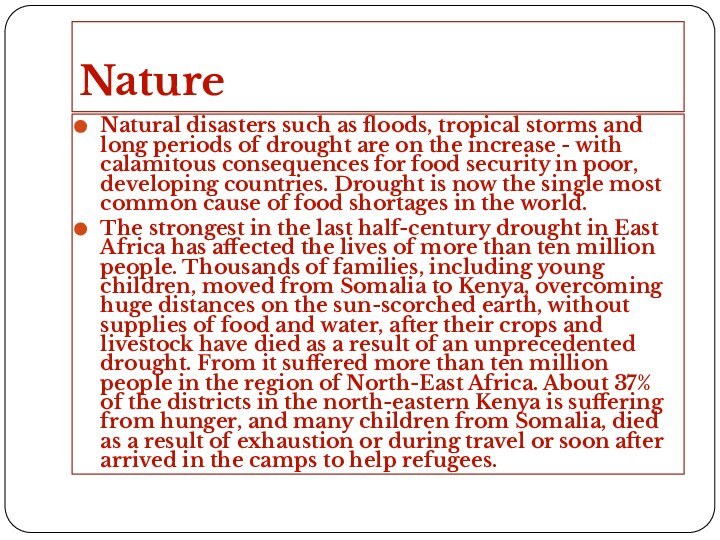Слайд 2
Introduction
Hunger
and poverty - it is not just one of
a variety of global issues. Hunger and poverty - this is the first promise to the fact that society is not perfect. Hunger and poverty is a problem and effect at the same time, a vicious circle from which escape is very difficult.
Across the world there are millions of people starving. Approximately 21,000 people die everyday due to hunger. Yet collectively we produce enough food to easily feed the population. Sadly, a food crisis will be felt most virulently in the places which are most deprived. While some poor nations struggle to feed their people due to the destructive forces of nature, it is not uncommon for a food crisis to be worsened by exploitation and corruption.
Слайд 3
Most of the world’s hungry live in developing
countries .
According to the latest Food and Agriculture Organization
(FAO) statistics, there are 925 million hungry people in the world and 98 percent of them are in developing countries. They are distributed like this:
million in Asia and the Pacific
265 million in Sub-Saharan Africa
53 million in Latin America and the Caribbean
42 million in the Near East and North Africa
“Leaders”…
In the ranking of "very hungry" countries is extremely
difficult to choose the leaders ... The crowds of starving refugees as a result of the transparency of borders fleeing from one country to another, hunger runs with them. In the north-west of the African continent, in the heart of the Sahara, it is located the State of Niger. It is in this country is the most arid region of Africa. It is no secret that the latter fact is used as an excuse for savage hunger that reigns in this country for decades. The country, which has no outlet to the sea and fertile land, but has rich mineral resources, obscene beggar. Niger is suspended antireytinga leader. Let's just say, when considering the problems of the African famine this state is referred to more often. Still, on revenues of $ 0.75 (0.5 euros) per capita. Niger poverty indicators have long been competing with other "leader" of the western part of the continent - Sierra Leone.
Слайд 5
Causes:
Nature: earthquake, floods, drought
War: displaced people, food used
as a weapon, farm and wells mined
Poverty Trap:
poor farmer cannot afford seeds and poor people cannot afford to buy food
Lack of investment in agriculture
Unstable markets
Food wastage
Слайд 6
Nature
Natural disasters such as floods, tropical storms and
long periods of drought are on the increase -
with calamitous consequences for food security in poor, developing countries. Drought is now the single most common cause of food shortages in the world.
The strongest in the last half-century drought in East Africa has affected the lives of more than ten million people. Thousands of families, including young children, moved from Somalia to Kenya, overcoming huge distances on the sun-scorched earth, without supplies of food and water, after their crops and livestock have died as a result of an unprecedented drought. From it suffered more than ten million people in the region of North-East Africa. About 37% of the districts in the north-eastern Kenya is suffering from hunger, and many children from Somalia, died as a result of exhaustion or during travel or soon after arrived in the camps to help refugees.
Слайд 7
War
Across the globe, conflicts consistently disrupt farming and
food production. Fighting also forces millions of people to
flee their homes, leading to hunger emergencies as the displaced find themselves without the means to feed themselves. The conflict in Syria is a recent example.
In war, food sometimes becomes a weapon. Soldiers will starve opponents into submission by seizing or destroying food and livestock and systematically wrecking local markets. Fields are often mined and water wells contaminated, forcing farmers to abandon their land.
Ongoing conflict in Somalia and the Democratic Republic of Congo has contributed significantly to the level of hunger in the two countries. By comparison, hunger is on the retreat in more peaceful parts of Africa such as Ghana and Rwanda.
Слайд 8
Lack of investment in agriculture
Too many developing countries
lack key agricultural infrastructure, such as enough roads, warehouses
and irrigation. The results are high transport costs, lack of storage facilities and unreliable water supplies. All conspire to limit agricultural yields and access to food.
Investments in improving land management, using water more efficiently and making more resistant seed types available can bring big improvements.
Research by the UN Food and Agriculture Organization shows that investment in agriculture is five times more effective in reducing poverty and hunger than investment in any other sector.
Слайд 9
Poverty trap
People living in poverty cannot afford nutritious
food for themselves and their families. This makes them
weaker and less able to earn the money that would help them escape poverty and hunger. This is not just a day-to-day problem: when children are chronically malnourished, or ‘stunted’, it can affect their future income, condemning them to a life of poverty and hunger.
In developing countries, farmers often cannot afford seeds, so they cannot plant the crops that would provide for their families. They may have to cultivate crops without the tools and fertilizers they need. Others have no land or water or education. In short, the poor are hungry and their hunger traps them in poverty.
Слайд 10
Unstable markets
In recent years, the price of food
products has been very unstable. Roller-coaster food prices make
it difficult for the poorest people to access nutritious food consistently. The poor need access to adequate food all year round. Price spikes may temporarily put food out of reach, which can have lasting consequences for small children.
When prices rise, consumers often shift to cheaper, less-nutritious foods, heightening the risks of micronutrient deficiencies and other forms of malnutrition.
Слайд 11
Food wastage
One third of all food produced (1.3
billion tons) is never consumed. This food wastage represents
a missed opportunity to improve global food security in a world where one in 8 is hungry.
Producing this food also uses up precious natural resources that we need to feed the planet. Each year, food that is produced but not eaten guzzles up a volume of water equivalent to the annual flow of Volga River. Producing this food also adds 3.3 billion tonnes of greenhouse gases to the atmosphere, with consequences for the climate and, ultimately, for food production.
Слайд 12
What we can do here at home?
Educate
The first
and most important step to get involved in solving
world hunger is to educate yourself and others about the problem. There are literally thousands of charities out there, some better run than others, offering initiatives to put food on the table for those in need. Armed with this knowledge, spread the word far and wide. Share the articles which have left you enlightened, and help others understand how to solve world hunger once and for all.
Volunteer
Contacting a range of charities and offering to be a volunteer can provide essential support to organizations helping people around the world.
Donate
One of the most effective ways to help that are available to us - it is a donation. With the help of donations to charitable organizations, we can contribute to helping the poor and the hungry
Слайд 13
Conclusion
It is easily within the capacity of

the global society to eradicate poverty and hunger in
a short period of time. There must be political will to achieve this, and the objective must be addressed directly rather than obliquely.
The need to achieve substantial and sustainable poverty reduction, requires that concrete steps be taken to promote agriculture and rural development. Three fourths of the poor live in rural areas and derive the basis for their livelihoods from agriculture or from rural activities which depend on the agricultural sector for their survival. Agriculture and rural development is therefore key to achieving overall economic growth and poverty reduction for most developing countries.
The need to achieve substantial and sustainable poverty reduction, requires that concrete steps be taken to promote agriculture and rural development. Three fourths of the poor live in rural areas and derive the basis for their livelihoods from agriculture or from rural activities which depend on the agricultural sector for their survival. Agriculture and rural development is therefore key to achieving overall economic growth and poverty reduction for most developing countries
National and international funding for hunger eradication and agriculture and rural development must be sufficient to meet requirements. It must be advanced under affordable terms and conditions that do not lead to increased indebtedness among developing countries











































